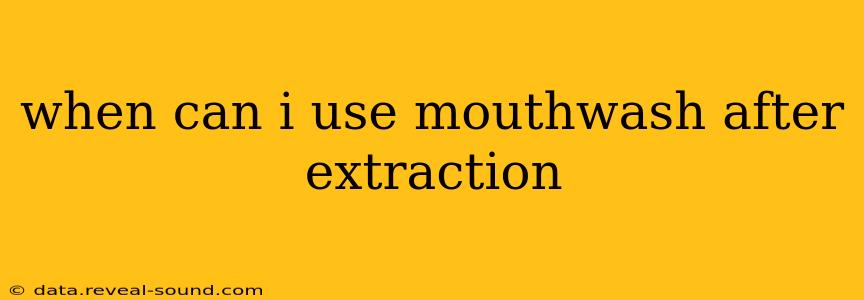Tooth extraction, while a common procedure, leaves your mouth vulnerable. Knowing when and how to use mouthwash afterward is crucial for proper healing and preventing infection. This guide will address common concerns and provide clear, evidence-based advice.
What Happens After a Tooth Extraction?
Following a tooth extraction, a blood clot forms in the socket. This clot is essential for healing; it protects the underlying bone and nerves, preventing dry socket—a painful and potentially serious complication. The healing process typically takes several weeks, during which the socket gradually fills with new bone and gum tissue. Rinsing too soon or using the wrong type of mouthwash can dislodge this crucial clot.
When Can I Rinse My Mouth After a Tooth Extraction?
The general recommendation is to wait at least 24 hours after your tooth extraction before using any mouthwash. This allows the blood clot to form properly and stabilize. Even then, it's crucial to use the right kind of mouthwash and use it correctly.
What Kind of Mouthwash Should I Use After Extraction?
Avoid using alcohol-based mouthwashes or those containing harsh chemicals immediately after an extraction. These can irritate the extraction site and interfere with healing. Instead, your dentist might recommend a gentle saltwater rinse (a teaspoon of salt dissolved in a cup of warm water) or a chlorhexidine gluconate (CHG) mouthwash.
Is saltwater rinse safe after tooth extraction?
Yes, a saltwater rinse is generally considered safe and effective after a tooth extraction. Its gentle cleansing action can help remove food particles and debris without disrupting the blood clot. However, avoid forceful rinsing or swishing. Gently rinse and spit.
When can I use Chlorhexidine (CHG) mouthwash after a tooth extraction?
Chlorhexidine is a powerful antiseptic mouthwash that can help prevent infection. However, it’s typically recommended to use CHG mouthwash only after the initial 24-hour period and only if prescribed by your dentist. CHG can stain teeth and may cause temporary taste alterations. Follow your dentist's instructions carefully regarding its use.
Can I use Listerine or other commercial mouthwashes after a tooth extraction?
Avoid using alcohol-based mouthwashes like Listerine immediately following an extraction. The alcohol can dry out the socket and disrupt healing, increasing the risk of dry socket. Wait until your dentist gives you the go-ahead before using any commercial mouthwash other than a CHG rinse prescribed by them.
How Should I Rinse My Mouth After a Tooth Extraction?
When rinsing, use gentle, non-forceful movements. Avoid directly aiming the rinse at the extraction site, as this could dislodge the blood clot. Simply swish the rinse gently around your mouth and then spit it out.
What if I Develop Pain or Swelling?
Pain and some swelling are normal after a tooth extraction, but excessive pain or swelling could indicate a problem. Contact your dentist immediately if you experience:
- Severe or persistent pain
- Excessive swelling
- Bleeding that doesn't stop
- Signs of infection (fever, pus)
Conclusion:
Patience and proper aftercare are key to successful healing after a tooth extraction. Always follow your dentist's instructions carefully regarding mouthwash use. Remember that a 24-hour waiting period before rinsing, gentle techniques, and the use of appropriate mouthwash solutions can significantly reduce the risk of complications and promote optimal healing. Contact your dentist with any concerns.
